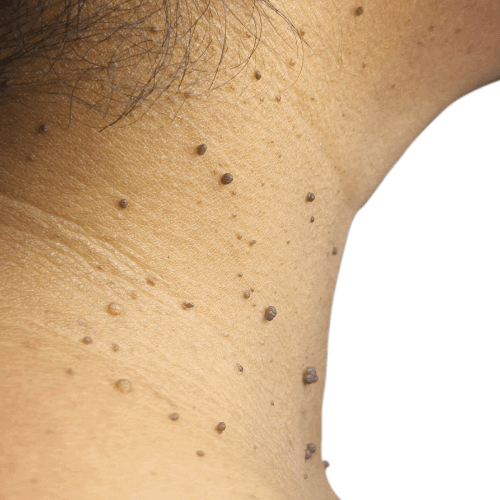Skin tags are common, benign growths that appear on the skin. They can be bothersome, particularly if they are located in visible or friction-prone areas. If you’re considering addressing skin tags, understanding your treatment options is crucial. This guide will explore various aspects of skin tag removal treatment(علاج إزالة علامات الجلد), including methods, considerations, and aftercare.
What Are Skin Tags?
Definition and Characteristics
Skin tags, medically known as acrochordons, are small, soft, benign growths that hang off the skin. They are typically flesh-colored or slightly darker and can vary in size. Skin tags are usually harmless but can be a cosmetic concern or cause discomfort if they get irritated.
Causes and Risk Factors
Skin tags can develop due to a combination of factors:
- Friction: Areas where skin rubs against skin or clothing are more prone to skin tags.
- Genetics: A family history of skin tags may increase your risk.
- Obesity: Excess weight can lead to more skin folds and friction.
- Diabetes: People with diabetes or insulin resistance may be more likely to develop skin tags.
Types of Skin Tag Removal Treatments
Over-the-Counter Treatments
Over-the-counter treatments are convenient and can be used at home. They generally involve products designed to freeze, burn, or cut off the skin tag. Some popular options include:
- Cryotherapy Kits: These kits use freezing methods to remove skin tags.
- Chemical Treatments: Solutions containing acids that dissolve skin tags.
While these treatments can be effective for some, they may not be suitable for all skin types or sizes of tags.
Professional Treatments
For more stubborn or larger skin tags, professional treatments might be necessary. These treatments are typically performed in a clinical setting:
- Electrosurgery: Uses electrical currents to burn off skin tags.
- Cryotherapy: Administers liquid nitrogen to freeze and remove skin tags.
- Laser Surgery: Uses a laser to precisely remove skin tags with minimal bleeding.
- Surgical Excision: Involves cutting off the skin tag with a scalpel, often used for larger or more problematic tags.
Choosing the Right Treatment
Factors to Consider
When selecting a skin tag removal treatment, consider the following factors:
- Size and Location: Larger tags or those in sensitive areas may require more specialized treatments.
- Skin Type: Different treatments may be better suited for various skin types and sensitivities.
- Pain Tolerance: Some treatments may cause discomfort or require a period of recovery.
- Cost: Treatments vary in cost, with professional options generally being more expensive.
Home Remedies vs. Professional Solutions
Home remedies can be a cost-effective solution but may lack the precision and efficacy of professional treatments. Remedies like tea tree oil, apple cider vinegar, or over-the-counter kits can sometimes be effective but might require longer periods to see results.
Professional solutions offer more immediate and reliable results, especially for larger or problematic skin tags. However, they typically involve higher costs and may require a visit to a clinic.
Preparing for Skin Tag Removal
Pre-Treatment Steps
Before undergoing any skin tag removal treatment, it is essential to prepare adequately:
- Consultation: If opting for a professional treatment, consult with a specialist to assess the skin tag and determine the most appropriate method.
- Avoid Irritants: Refrain from using harsh skin products or treatments that may irritate the area around the skin tag.
- Clean the Area: Ensure the area is clean and free of any lotions or oils that may interfere with the treatment.
What to Expect
Understanding what to expect during and after the procedure can help ease anxiety:
- During the Treatment: Most treatments are relatively quick and may involve some discomfort or pain.
- Aftercare: Follow post-treatment instructions carefully to minimize risks of infection or scarring.
Aftercare and Recovery
Post-Treatment Care
Proper aftercare is crucial for a smooth recovery:
- Keep the Area Clean: Gently clean the treated area with mild soap and water.
- Avoid Irritation: Protect the area from friction and avoid applying any irritating products.
- Monitor for Infection: Watch for signs of infection, such as increased redness, swelling, or pus.
Potential Side Effects
While skin tag removal treatments are generally safe, they may come with some side effects:
- Minor Pain or Discomfort: Temporary pain or discomfort is common but usually subsides quickly.
- Swelling or Redness: Some swelling or redness can occur but should diminish within a few days.
- Scarring: There is a potential for scarring, especially with more invasive treatments. Proper aftercare can help minimize this risk.
Conclusion
Understanding the various skin tag removal treatments available can help you make an informed decision about how to address skin tags effectively. Whether you opt for an over-the-counter solution or professional treatment, considering factors such as size, location, and skin type will guide you in choosing the best option for your needs.
By following proper preparation and aftercare guidelines, you can ensure a successful treatment process with minimal complications. Always consult with a healthcare professional if you have any concerns or questions about the best approach for your specific situation.





Comments